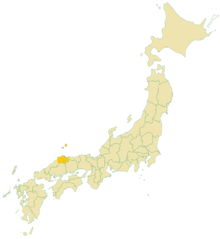Umpaku dialect
| Umpaku Japanese | |
|---|---|
| Native to | Japan |
| Region | eastern San'in |
|
Japonic
| |
| Language codes | |
| ISO 639-3 | – |
| Glottolog |
umpa1238[1] |
|
Umpaku-dialect area | |
The Umpaku dialect (雲伯方言 Unpaku hōgen) is a group of the Japanese dialects spoken in central San'in region. The name Unpaku (雲伯) is constructed by extracting a representative kanji from Izumo (出雲) and Hōki (伯耆), names of old provinces there.
The Umpaku dialect are:
- Izumo dialect (eastern Shimane Prefecture, formerly known as Izumo Province)
- Yonago dialect (western Tottori Prefecture centered Yonago)
- Oki dialect (Oki islands of Shimane Prefecture)
Pronunciation
Umpaku dialect, especially Izumo-ben, unique from other dialects in Chūgoku region, superficially resembles Tōhoku dialects in pronunciation and is thus also called Zūzū-ben. It has neutralization of the high vowels "i" and "u".
Vowels
Voiceless vowel sounds are common in most western Japanese accents and this is no different in Izumo where it is commonly heard. In Izumo and western Hoki, just like the Tohoku dialects "i" and "u" sounds are inflected. "i" is commonly pronounced [ï] and "u" [ɯ̈].
Consonants
The dropping of "r" sounds
In Izumo and western Hoki dialects, "r" sounds are often excluded and an elongation of the previous sound fills it place. e.g. dare > daa "who", arimasu > aamasu "there is". In particular this often happens to "ri" and "ru" sounds which are almost all replaced by this elongated sound. In some areas, shiroi "white" becomes shie and akeru "to open" becomes akyae. In Oki, these sounds are also replaced by sokuon such as sono tsumodda (sono tsumori da).
Remnants of archaic sounds
- kwa, gwa
- These voicings are prominent in the area and are non standard sounds for modern Japanese.
- f instead of h
- In the Heian period, all of the "h" row of sounds were pronounced with an "f" sound [ɸ] rather than with a "h" i.e. fa, fi, fu, fe, fo. Izumo still keeps this pronunciation. For example: fashi [ɸasï] = hashi "chopsticks", febi [ɸebï] = hebi "snake"
- se, ze
- In pronunciation "se" becomes "she" and "ze" becomes "je".
Vocabulary
- kariru(かりる) - "to borrow", karu in other western Japanese.
- dandan(ダンダン) - "Thank you", arigatō in Standard Japanese. not used within the family, used in conversion with unknown people in much the same was as Standard Japanese dōmo is used as an abbreviation.
- gosu (ごす)- "to give (to speaker)", kureru in Standard Japanese. e.g. X-san ga wa ni yasai o goita wa "Mr.X gave me vegetables." For a more polite form goshinaru is also used。
- kyotoi(きょとい) - "scary, frightening", kowai in Standard Japanese. e.g. maa, ano hito wa kyotoi wa! "Oh, that person is scary!", aa! kyoto, kyoto! nigetoku da wa! "Oh, how scary he is! Let's escape!"
- chonboshi(ちょんぼし)or also chokkoshi(ちょっこし) - "a little", sukoshi or chotto in Standard Japanese.
- gaina (がいな)- "giant", sugoi or gotsui in Standard Japanese. An animation studio Gainax is named after gaina.
- banjimashite(ばんじまして) - "good evening", konbanwa in Standard Japanese.
References
- ↑ Hammarström, Harald; Forkel, Robert; Haspelmath, Martin; Bank, Sebastian, eds. (2016). "Umpaku". Glottolog 2.7. Jena: Max Planck Institute for the Science of Human History.
External links
- 正しい?出雲弁講座 (Japanese)
